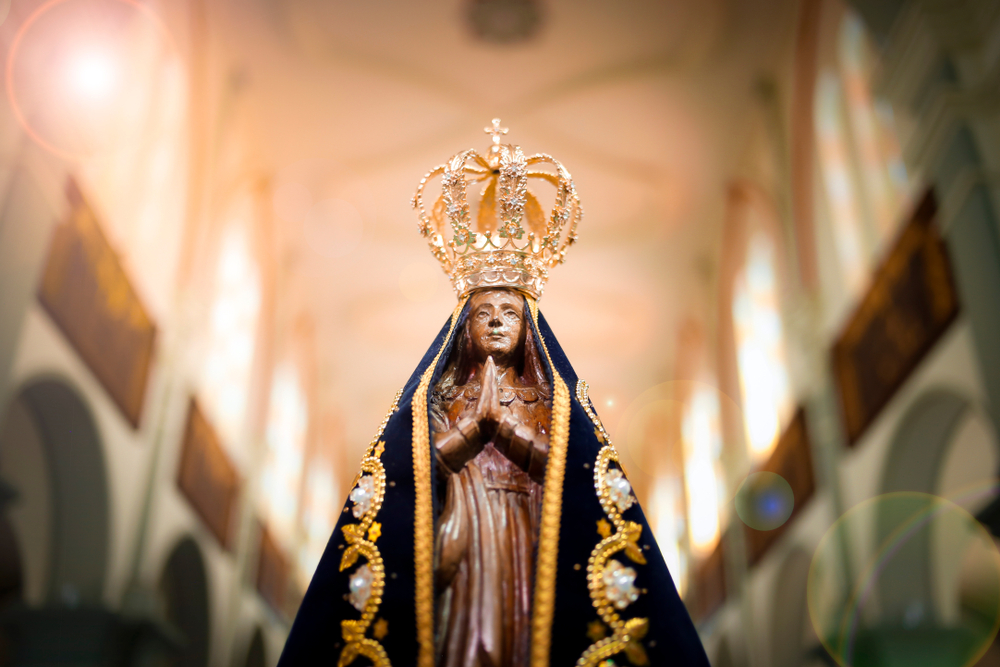October 12 is a religious holiday in Brazil to celebrate Our Lady of Aparecida, the country’s patron saint. According to local legend, on October 12 of 1717, three poor fishermen came across the image of a black Virgin Mary in a river some 170 kilometers from São Paulo. As legend has it, after finding the object, the trio miraculously began to catch hordes of fish.
In a book about the statue and its religious and political significance in Brazil, journalist Rodrigo Alvarez points out what he believes to be the most likely explanation for the feat, that the object had been broken and discarded into the river. At the time, many believed that possessing a damaged image of a saint brought bad luck.
Indeed, the saint is unlikely to have originally been black, instead being discolored after a long time underwater.

From little-known miracle to Brazil’s patron saint
Experts say that devotion to Our Lady of Aparecida took a long time to spread across Brazil, being initially restricted to black Brazilians around the Southeast of Brazil, due to the saint’s status as a black Madonna. A chapel was built for her in the mid-1700s, close to the river where the fabled image was found.
For theologist and philosopher Fernando Altemeyer Júnior, a professor at the Pontifical Catholic University of São Paulo, the fame of Our Lady of Aparecida spread with the work of Redemptorist missionaries, who began services in the region in 1895.
“Slowly, popular devotion was taken over by the Catholic Church. The fervor was amplified with the arrival of the Redemptorists and, later, with the construction of the Dutra highway,” he told newspaper O Estado de Minas. The original chapel was built in a region that was practically equidistant from the major cities of Rio de Janeiro and São Paulo, and the city of Aparecida was built around it in the 20th century. The building of a new highway joining Rio and São Paulo only served to spread devotion to the saint further. There is no consolidated data on the number of churches devoted to Our Lady of Aparecida throughout Brazil, but she is certainly the saint with the most popular devotion in the country.
In his book about Brazil’s imperial history, Mr. Altemeyer Júnior writes that Pedro I — the first ruler of independent Brazil — visited the chapel in 1822, during a trip from then-capital city Rio de Janeiro to São Paulo. Soon after, he declared that the country was breaking ties with the Portuguese crown.
Our Lady of Aparecida was made Brazil’s patron saint in 1930 by way of a papal bull from Pope Pius XI, replacing Saint Peter of Alcântara. October 12 would only become a national holiday in 1980, under the government of President João Figueiredo, the last of the military dictatorship’s rulers.
As with many ancestral tales, historians believe details of the finding of the Our Lady of Aparecida statue were apocryphal, suggesting it occurred much later in the month, with her feast day being moved to October 12 to coincide with Columbus Day and Pedro I’s own birthday.

The importance of October 12
These days, the statue is housed in a basilica in the city of Aparecida — Brazil’s most popular pilgrimage site. Millions of people flock to the city every October 12, though the basilica suspended its annual mass last year due to the coronavirus pandemic.
Pope Francis visited the church during a trip to Brazil in 2013, giving a mass for those in attendance. In 2017, he granted the image its third golden rose, marking the 300th anniversary of devotion to Our Lady of Aparecida.
Indeed, October 12 has extra importance in Brazil, being the date on which the country celebrates Children’s Day. While most countries honor children on November 20 to commemorate the Declaration of the Rights of the Child by the UN General Assembly in 1959, Brazil observes the red-letter day in October, marking the anniversary of the South American Congress for Children, held in Rio de Janeiro in 1923.
In recent decades, Children’s Day has been regarded by retailers as one of its biggest days of the year. But this wasn’t always the case, and Children’s Day was barely acknowledged in Brazil up until the mid-1950s. This lack of interest from the public began to change after a toy company created a marketing campaign for the holiday called the “Robust Baby Week.”
Despite its questionable name, the ploy worked, and several retailers decided to invest in their own ad campaigns for the week of October 12 in the following years.











 Search
Search






































